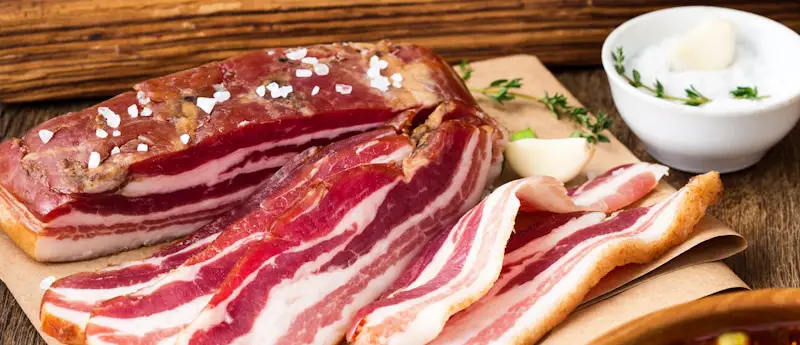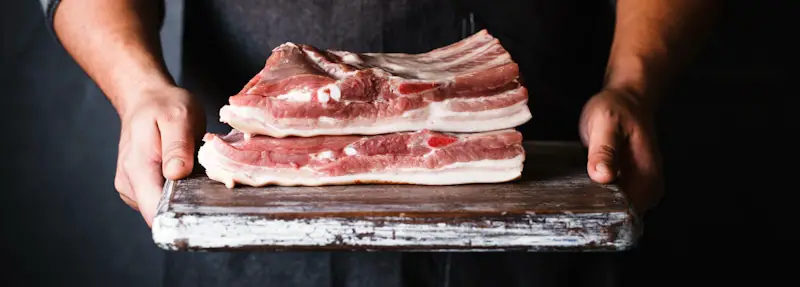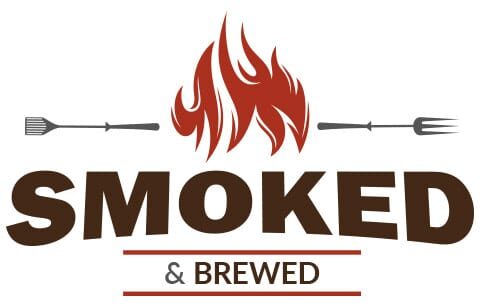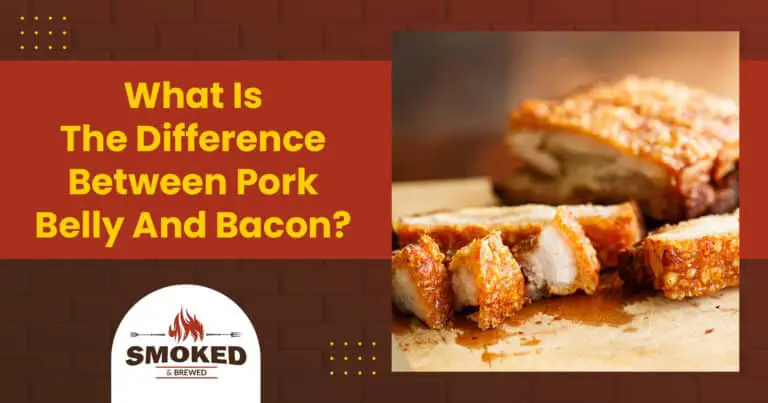If you love pork, you might already be a fan of the two best things – ‘low and slow roasted pork belly’ and ‘quick and easy pork bacon’. While the pork belly is a true BBQ hero with its tender and juicy character that easily falls apart in the mouth, bacon serves to add more flavor, crispiness, and a salty finishing to wraps, salads, sandwiches, and many sides or breakfast dishes.
Pork Belly is raw meat obtained from the underside of the animal, while Bacon is a processed and cured version obtained from the belly region as well as other parts like the shoulders and sides of the animal. Pork belly is fattier, versatile, and more flavorful than bacon. In short, ‘Bacon is Pork Belly but Pork Belly is not Bacon’. Bacon can be processed from pigs, turkeys, ducks, and other animals.
If you were to choose between pork belly and bacon, the choice of cut will depend upon what dish you are cooking. For instance, many Asian dishes prefer using pork belly, while bacon is usually one of the most popular ‘go-to’ meats of choice in American cuisine. So is pork belly better or bacon? How do they differ in taste? Continue reading to learn more about Pork Belly vs Bacon.

What Is Pork Belly Bacon?
A pork belly is a cut of meat obtained from the underside, or the ‘belly region’ of the pig (along its ventral line). As one can imagine, it is of course the fattiest cut of meat, which also makes it versatile. It can be used for preparing a variety of dishes. When the butcher processes the underside of the meat, he will generally remove the spare ribs and the loins, and what remains is a fatty slab of pork belly.
Pork belly is typically sold as large slabs of meat and people prefer having them as long and about 1-inch thick strips. Many buyers also seek cubed pieces of fatty pork belly to add to vegetables, stews, soup, pasta, and other dishes.
What Is Bacon?
The word Bacon is derived from Old French and it means ‘back’. It is not exactly a cut of meat, but rather a process. Bacon is obtained by submerging the entire chunk of meat in a brine solution (containing high amounts of salt and water). This process is known as ‘curing’. The process of curing preserves the meat and gives it a characteristic ‘pink’ color. This pink color oxidizes with time and the color change indicates how old the stock is.
Some take a step further and add more flavor to the meat by smoking it low and slow before it is finally packaged and presented to customers. Most American Grocery stores are filled with racks of cured bacon in their meat or packaged food section. Bacon is, in fact, a very general term and you may also find duck bacon, beef bacon, turkey bacon, etc.
Is Pork Belly Same As Bacon?
As explained above, pork belly and bacon are not similar. Though the source may be the same, the final product is certainly different. While the pork belly is strictly derived from the belly region, bacon can be obtained from the belly area as well as other parts.
Apart from the belly area (often called ‘Streaky bacon’), bacon can also be derived from other areas of the pig. For instance, ‘Back bacon’ comes from the loin area (low in fat), ‘Jowl Bacon’ from the cheek meat, ‘Cottage Bacon’ from pork shoulders, and ‘Slab bacon’ which is an inexpensive cut typically obtained from sides of the pig and is used for making lardons, stews, soup, or grease for stir-frying.
Both Bacon and Pork Belly are not a healthy choice since they are high in cholesterol and saturated fat content which are not good for heart health and the weight of an individual.
What Types Of Dishes Are Made With Pork Belly And Bacon?
Bacon is used to improve the flavor and texture of food such as salads and sandwiches. Bacon can be had at all times of the day, including breakfast, lunch, or dinner. Some of the famous dishes with bacon as the key ingredient are – Bacon and eggs, Crispy Bacon Strips, Bacon Fettuccine Alfredo Pasta, Bacon Mac and Cheese, Bacon Burger, etc. You may also shred or cut bacon into pieces and sprinkle them on top of a pizza. In fact, bacon can go with just anything!
In contrast, pork Belly is more famous in deep-dried Filipino recipes and braised or boiled Chinese dishes. The best pork belly is the one that falls apart from the bone easily and is tender and juicy in the mouth. Pork Belly can also be roasted low and slow in the smoker. With roasted pork belly, some of the famous dishes are Pork Belly Sandwich, Honey Glazed Pork Belly, BBQ Pork Belly, Pork Belly Salad, and others.
How Is Pork Belly Different From Bacon
The major difference between pork belly and bacon lies in the ‘curing’ process. While bacon is cured meat that undergoes the process of salting and infusion of nitrates to preserve the meat, pork belly is raw, uncut meat obtained from the animal. Pork Belly is, of course, fattier than bacon and there’s a big difference between the calories.
Thus, bacon is more ‘market ready’ or often sold as a packaged item, while pork belly needs some processing for making it fit to eat. Once purchased, pork belly should be cleaned and stored immediately to prevent spoilage. As directed by the USDA, both cuts should be refrigerated within 2 hours of cooking or being left outside.

How Does Pork Belly And Bacon Differ In Taste
Since bacon is processed, it has a very different taste from pork belly. Most people love eating bacon as it feels ‘cleaner’ than pork belly. Pork belly has an ultimate umami feeling and tastes delicious. If you do not like fatty meat, you would probably opt for bacon. Bacon is often added to improve the taste of otherwise bland food. The latter has umami and salty taste with a crispy texture.
Conclusion
Pork belly chunks or slices are vividly used in Asian cooking. The various kinds of spices, condiments, and sauces used in Asian cuisine perfectly compliments the texture and the fattiness of pork belly. In American or European cuisine, Brisket-styled pork belly is more famous. In a nutshell, we can differentiate pork belly vs bacon as follows:
| Parameters | Pork Belly | Bacon |
| Obtained from | Belly region | Belly region, cheek area, shoulder, and other fatty areas of pig. |
| Is it cured meat? | No | Yes. The process of curing extends the shelf-life and prevents spoilage and the growth of microorganisms. |
| The average amount of calories per pound (raw) | ~2,400 | ~2,000 |
| Fat Content | More | Less |
| Type of Cut | Usually 1-inch Thick Cuts | Thin |
| Are they Pre-Smoked? | No | Usually, it is available as smoked meat over woods like Apple and Hickory. |
| Flavor | Since the meat is uncured, the user would need to add salt and flavors during the cooking process. | It has a salty flavor. If the bacon is smoked, it will additionally have smoky flavors depending on the type of wood used. |
| Meal | Since pork belly is high in fat content, it is usually eaten at lunch or dinner. | Bacon can be had at any time of the day. |
| Price | Low | Usually it is costlier because of the curing process. |
| Uses | The cut is versatile and you can literally use it in any recipe and method like oven roasting, braising, frying, slow cooking, and smoking. | Slices of thin-cut bacon are usually fried in a shallow pan and are ready to serve or they are sometimes added to soups, stews, or other dishes to enhance the flavor. |
Final Thoughts
So if you were to choose between pork belly and bacon, then pork belly should be the obvious choice for slow cooking, oven roasting, deep frying, making a stew or noodles, braising, and grilling. For all other quick recipes, bacon is a good pick to add some instant flavor with fewer calories.
Scot has loved smoking food in his free time for the last few years. Each major holiday or off-weekend, Scot spends days testing and prepping new recipes for perfection.

